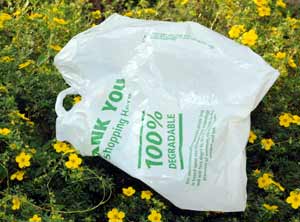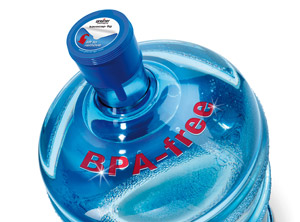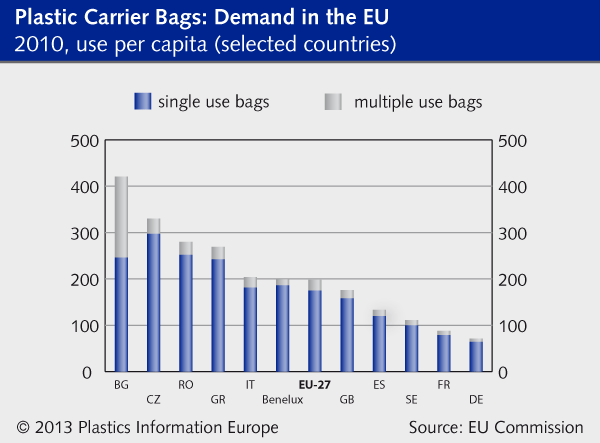YEAR IN REVIEW 2013
Part 3 – Environmental challenges keep industry on the alert / Biodegradables and plastic bag bans make headlines / Recycling moves forward but players say full potential not reached
The European plastics industry faced its share of environmental challenges in 2013, not all of which were of its own making. A permanent solution to the perpetual problem of marine litter once again eluded the world’s grasp, but along with new debris finds in the Pacific gyre early in the year there were some novel ideas about what to do about it. Led by the producers’ association PlasticsEurope, the industry underscored its responsibility for the products it makes, pressing ahead with its “Zero Plastics to Landfill" initiative and stepping up its efforts at recycling.
 The European Commission has proposed a controversial solution to reduce consumption of one-way, ultra-light plastic bags within the 29 member states (Photo: PIE) |
Unavoidably, the topic of whether plastic bags are a scourge that should be done away with, or whether charging for hand-outs would help solve the problem occupied the attention of plastics producers and converters as well as public authorities and environmentalists again in 2013. Just before the end of 2012, a European Union survey found that most citizens favoured some sort of regulation and nearly a year later the European Commission announced guidelines requiring member states to choose how to best implement their own “appropriate” rules. This idea was not well received by industry associations such as European Plastics Converters (EuPC), which slammed it as “an attack on the internal market.”
Responsible care for plastics, foremostly the continued critical evaluation of the role of plastics packaging in the environment may well have been the catchword that united all of the industry’s discussions over the past year. Along with the ocean debris that poses a threat to marine life, dialogue participants also spotlighted concerns about public health. In reaction to the ongoing controversial discussion over the possible leaching of bisphenol A (BPA) into packaging, Austria’s Greiner Packaging International announced it would phase out the use of BPA-containing plastics in its food packaging products – mainly polycarbonate water bottles.
Responsible care for plastics, foremostly the continued critical evaluation of the role of plastics packaging in the environment may well have been the catchword that united all of the industry’s discussions over the past year. Along with the ocean debris that poses a threat to marine life, dialogue participants also spotlighted concerns about public health. In reaction to the ongoing controversial discussion over the possible leaching of bisphenol A (BPA) into packaging, Austria’s Greiner Packaging International announced it would phase out the use of BPA-containing plastics in its food packaging products – mainly polycarbonate water bottles.
 Increasingly, European companies are turning away from using BPA in their food and beverage packaging (Photo: Greiner Packaging) |
Analyses of public attitudes toward packaging in the recent past have come to surprising conclusions, with the results varying according to who was asking whom which questions. The study “Packaging 2020”, by Swedish market research institute Innventia, found consumers in India were three times more concerned about the impact of plastic packaging on the environment than their counterparts in Sweden, with 60% of Indians prepared to avoid purchasing a particular product if the packaging is environmentally unfriendly, compared with only 20% of Swedes. In another unexpected twist, a US study on grocery bags and foodborne illnesses examined the link between San Francisco’s 2007 plastic bag ban and the rise in emergency room admissions for E. coli infections – purported to show that bans on plastic bags are bad for health.
Plastic bag regulation is the EU’s mega trend
Within the EU, the topic – or mega trend, to use a popular corporate term – most on people’s minds in 2013 was what action Brussels would take to rein in plastic bag consumption. “Every year, more than 8 bn plastic bags end up as litter in Europe,” the EU's environment commissioner, Janez Potocnik, said in early November when presenting the Commission’s plans. If all member states followed the measures adopted by states already on top of the problem, total consumption could be reduced by 80%, he suggested.
 | |
Manufacturers of plastic bags as well as most participants in the discussion acknowledge that the bags are less of a problem than the casual attitude displayed by consumers, particularly in southern Europe. In Italy, where carrier bags with a thickness of less than 50 microns literally dot the landscape and often find their way into the Mediterranean or Adriatic Sea, authorities in 2012 took steps toward regulation, but within the EU, the plans ran afoul of the UK’s distaste for imposing fines. In Northern Ireland, a 5p (EUR 0.06) levy on plastic carrier bags has gone into effect. The Commission’s aim is for an amended Packaging and Packaging Waste Directive to reduce single-trip bag consumption within two years.
As could be expected, the bioplastics industry has welcomed suggestions in some quarters that biodegradable packaging be exempted from any carrier bag restrictions, even if some organisations with less vested interests, such as the EuPC, have cast some doubt on the sustainability of such products. Compostable and biodegradable products should stay out of waste streams, the converters’ organisation said, emphasising that it does not believe biodegradables are a solution to the marine litter problem.
Recycling could help reduce marine litter
Two original ideas about solving the marine litter problem were broached this year. In March, the UK plastic bag recycler Closed Loop Recycling and compatriot cleaning products manufacturer Ecover launched an initiative to recycle plastics waste retrieved from the sea. The two companies are working together to develop a new type of plastic made from recycled HDPE and sugar cane. In April, an adventurous approach to the problem was announced by a young Dutch entrepreneur. Boyan Slat’s “Ocean Cleanup Array” of 24 solar-powered multi-level manta ray-shaped floating platforms floor is designed to catch wastes driven toward them by wave action. In a "Ted" talk which went viral on YouTube, Slat describes the concept.
As for recycling, German recyclers in particular bemoaned the poor sorting of plastic waste and scrap and the need to compete with the incineration sector for volumes. This, they said, reflected not only environmental considerations, but also requirements of the country’s dual waste collection and sorting systems. German authorities launched a few trial balloons aimed at reforming the 20-year system, but most agreed the steps were too timid.
While the market’s difficult climate also played a role, PET recyclers in Germany said high energy costs disadvantaged home-grown companies in international competition for volumes. A green paper published by the European Commission proposed to come up with remedies but, as usual, more subjects were broached than anyone had answers to.
As for recycling, German recyclers in particular bemoaned the poor sorting of plastic waste and scrap and the need to compete with the incineration sector for volumes. This, they said, reflected not only environmental considerations, but also requirements of the country’s dual waste collection and sorting systems. German authorities launched a few trial balloons aimed at reforming the 20-year system, but most agreed the steps were too timid.
While the market’s difficult climate also played a role, PET recyclers in Germany said high energy costs disadvantaged home-grown companies in international competition for volumes. A green paper published by the European Commission proposed to come up with remedies but, as usual, more subjects were broached than anyone had answers to.
| YEAR IN REVIEW 2013 | |
| Part 1 | General overview (13.12.2013) |
| Part 2 | Shale Gas (17.12.2013) |
| Part 3 | Plastics & Environment (19.12.2013) |
| Part 4 | Plastics Machinery (20.12.2013) |
19.12.2013 Plasteurope.com [227032-0]
Published on 19.12.2013
